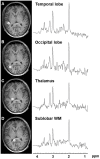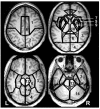The Distribution of Major Brain Metabolites in Normal Adults: Short Echo Time Whole-Brain MR Spectroscopic Imaging Findings
- PMID: 35736476
- PMCID: PMC9228869
- DOI: 10.3390/metabo12060543
The Distribution of Major Brain Metabolites in Normal Adults: Short Echo Time Whole-Brain MR Spectroscopic Imaging Findings
Abstract
This prospective study aimed to evaluate the variation in magnetic resonance spectroscopic imaging (MRSI)-observed brain metabolite concentrations according to anatomical location, sex, and age, and the relationships among regional metabolite distributions, using short echo time (TE) whole-brain MRSI (WB-MRSI). Thirty-eight healthy participants underwent short TE WB-MRSI. The major metabolite ratios, i.e., N-acetyl aspartate (NAA)/creatine (Cr), choline (Cho)/Cr, glutamate + glutamine (Glx)/Cr, and myoinositol (mI)/Cr, were calculated voxel-by-voxel. Their variations according to anatomical regions, sex, and age, and their relationship to each other were evaluated by using repeated-measures analysis of variance, t-tests, and Pearson’s product-moment correlation analyses. All four metabolite ratios exhibited widespread regional variation across the cerebral hemispheres (corrected p < 0.05). Laterality between the two sides and sex-related variation were also shown (p < 0.05). In several regions, NAA/Cr and Glx/Cr decreased and mI/Cr increased with age (corrected p < 0.05). There was a moderate positive correlation between NAA/Cr and mI/Cr in the insular lobe and thalamus and between Glx/Cr and mI/Cr in the parietal lobe (r ≥ 0.348, corrected p ≤ 0.025). These observations demand age- and sex- specific regional reference values in interpreting these metabolites, and they may facilitate the understanding of glial-neuronal interactions in maintaining homeostasis.
Keywords: echo-planar; magnetic resonance spectroscopic imaging; metabolite; whole-brain.
Conflict of interest statement
Yuta Urushibata is an employee of Siemens Healthcare K.K., and Sinyeob Ahn is an employee of Siemens Healthineers. The other authors declare no conflict of interest.
Figures





Similar articles
-
Comparison of reproducibility of single voxel spectroscopy and whole-brain magnetic resonance spectroscopy imaging at 3T.NMR Biomed. 2018 Apr;31(4):e3898. doi: 10.1002/nbm.3898. Epub 2018 Feb 13. NMR Biomed. 2018. PMID: 29436038 Free PMC article.
-
Role of MRSI Major Metabolite Ratios in Differentiating Between Intracerebral Ring-Enhancing Neoplastic and Non-Neoplastic Lesions, High-Grade Gliomas and Metastases, and High-Grade and Low-Grade Gliomas.Cureus. 2022 Nov 23;14(11):e31841. doi: 10.7759/cureus.31841. eCollection 2022 Nov. Cureus. 2022. PMID: 36579207 Free PMC article.
-
Reproducibility and reliability of short-TE whole-brain MR spectroscopic imaging of human brain at 3T.Magn Reson Med. 2015 Mar;73(3):921-8. doi: 10.1002/mrm.25208. Epub 2014 Mar 26. Magn Reson Med. 2015. PMID: 24677384 Free PMC article.
-
A short-echo-time proton magnetic resonance spectroscopic imaging study of temporal lobe epilepsy.Epilepsia. 2002 Sep;43(9):1021-31. doi: 10.1046/j.1528-1157.2002.50701.x. Epilepsia. 2002. PMID: 12199727 Clinical Trial.
-
Proton MR spectroscopy in Rett syndrome.Comput Med Imaging Graph. 2002 Jul-Aug;26(4):271-5. doi: 10.1016/s0895-6111(02)00016-2. Comput Med Imaging Graph. 2002. PMID: 12074922 Review.
Cited by
-
Brain Temperature as an Indicator of Cognitive Function in Traumatic Brain Injury Patients.Metabolites. 2023 Dec 27;14(1):17. doi: 10.3390/metabo14010017. Metabolites. 2023. PMID: 38248820 Free PMC article.
-
An MR spectroscopy study of temporal areas excluding primary auditory cortex and frontal regions in subjective bilateral and unilateral tinnitus.Sci Rep. 2023 Oct 27;13(1):18417. doi: 10.1038/s41598-023-45024-3. Sci Rep. 2023. PMID: 37891242 Free PMC article.
-
Quantitative Assessment of Intervertebral Disc Composition by MRI: Sensitivity to Diurnal Variation.Tomography. 2023 May 16;9(3):1029-1040. doi: 10.3390/tomography9030084. Tomography. 2023. PMID: 37218944 Free PMC article.
-
A Comparison of 7 Tesla MR Spectroscopic Imaging and 3 Tesla MR Fingerprinting for Tumor Localization in Glioma Patients.Cancers (Basel). 2024 Feb 26;16(5):943. doi: 10.3390/cancers16050943. Cancers (Basel). 2024. PMID: 38473305 Free PMC article.
References
Grants and funding
- R01 EB016064/EB/NIBIB NIH HHS/United States
- and the Global Institution for Collaborative Research and Education, Hokkaido University
- KAKENHI-15K01358/Grant-in-Aid for scientific research by the Japan Society for Promotion of Science
- KAKENHI-24591741/Grant-in-Aid for scientific research by the Japan Society for Promotion of Science
- R01EB016064/NH/NIH HHS/United States
LinkOut - more resources
Full Text Sources

